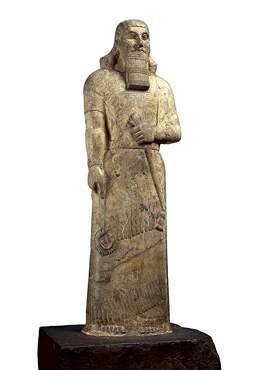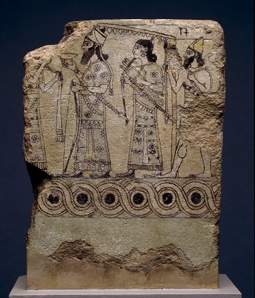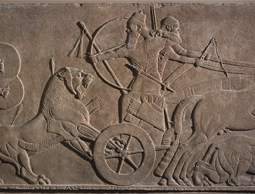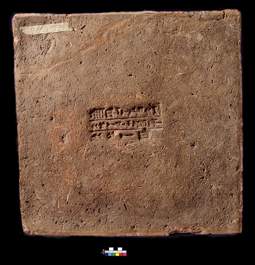Assurnasirpal II, king of Assyria (r. 883-859 BC)
The reign of Assurnasirpal II marked a turning point in the history of the Assyrian empire. His military exploits recaptured territories lost to Assyria centuries earlier, and established it as one of the most important powers in the Near East. But the crowning achievement of his reign was the creation of a magnificent capital city, Kalhu, built on a grand scale and lavishly decorated with carved stone reliefs TT in a new style. He was succeeded by his son, Shalmaneser III, who inherited the unenviable task of consolidating his father's impressive legacy as both military leader and builder.
The king on campaign

Image 1: This rare example of an Assyrian statue depicts king Assurnasirpal II (r. 883-859 BC) and originally stood in the temple of Ištar Šarrat-niphi in Kalhu. BM 118871. View information and larger image on British Museum website. © The Trustees of the British Museum
Assurnasirpal's inscriptions record a total of 14 military campaigns led by the king over the course of his 24 years on the throne. The early years of his reign in particular saw him conduct regular expeditions for both plunder and political control. The Assyrian war machine was made even more efficient at this time by advances in military technology. These included more effective siege machines and a greater emphasis on the use of cavalry rather than chariotry. This was particularly important in the mountainous regions to Assyria's north and northwest, where the use of chariots - which need flat terrain - was not practical.
Assurnasirpal was the first Assyrian king since Tiglath-pileser I PGP (r. 1114-1076 BC) to reach the Mediterranean Sea - an impressive feat which he celebrated by ceremonially washing his weapons in its waters and making sacrifices to the gods. He also paid a visit to the famous cedar TT forests of Lebanon PGP , whose exceptionally tall and straight trees had provided highly prized building materials for many generations of Mesopotamian kings. To mark the occasion and establish a symbolic Assyrian presence in the region, Assurnasirpal erected a commemorative stela TT on Mount Amanus PGP .
An important achievement of Assurnasirpal's reign was his contribution to the developing system of provincial TT administration. Annexed regions had to send regular tribute TT and were put under the control of Assyrian governors TT who reported directly to the king. To prevent uprisings, local people were deported en masse and resettled in other areas of the empire. Some of these deported people, gathered from various parts of the empire, were used to build and populate the city of Kalhu (1). Assurnasirpal also strengthened Assyria's control over its provinces by setting up fortified garrisons (some of which had previously functioned as depots for local harvests) from which further campaigns could be mounted easily and with minimal delay.
A profitable enterprise

Image 2: Fired clay tile with a design in yellow, black and green glaze TT , from Assurnasirpal's Northwest Palace. It depicts the king holding a cup and a bow and being attended by courtiers and a bodyguard. BM 90859. View large image on British Museum website. © The Trustees of the British Museum.
Assurnasirpal's military exploits may have increased Assyria's territories, but, just as importantly, they also added a great deal of wealth to the royal coffers, through both booty and tribute. Assurnasirpal's inscriptions included detailed accounts of the rich gifts received from foreign rulers keen to ally themselves with the powerful Assyrian state. The following extract provides an illustration of the sheer quantities which were involved:
I received tribute from Sangara, king of the land Hatti (i.e. Syria), 20 talents (i.e. 600 kg) of silver TT , a gold TT ring, a gold bracelet, gold daggers, 100 talents (i.e. 3 tonnes) of bronze, 250 talents (i.e. 7.5 tonnes) of iron, bronze (tubs), bronze pails, bronze bath-tubs, a bronze oven, many ornaments from his palace the weight of which could not be determined, beds of boxwood, thrones of boxwood, dishes of boxwood decorated with ivory TT , 200 adolescent girls, linen garments with multi-coloured trim, purple wool, red-purple wool, gišnugallu-alabaster TT , elephants' tusks, a chariot of polished (gold), a gold couch with trimming - (objects) befitting his royalty (2).
All this from a single king - and there were many more who sent lavish gifts to the royal court. It was this wealth, and access to other resources such as manpower and raw materials, which enabled Assurnasirpal to take on the costly and time-consuming project that was the rebuilding of Kalhu. The new city featured a walled citadel TT which was home to a magnificent royal palace (Image 2) as well as temples and administrative buildings. The southern part of the city contained a residential area for the city's 16,000 inhabitants. It also enclosed extensive gardens (irrigated by a canal which brought water to the city from the Greater Zab PGP river) as well as a zoo where animals captured during the king's campaigns or received as tribute were put on display. They provided entertainment for the people but also a tangible symbol of the greatness of the Assyrian empire, in which the ordinary citizens of Kalhu could share by seeing the exotic plants and animals.
The celebrations which marked the completion of the new city were no less impressive. They are described in detail in Assurnasirpal's so-called Banquet Stela which was displayed just outside Assurnasirpal's throne room, the ideological heart of the capital. According to the inscription, no fewer than 69,574 guests were wined and dined with no expense spared for 10 straight days before being sent back home "in peace and joy" (3).
An artistic revolution

Image 3: Detail of a gypsum wall panel relief from Assurnasirpal's Northwest Palace in Kalhu, showing the king hunting lions from a chariot. The royal lion hunt was a prominent theme throughout Mesopotamian history, and acted as a test and demonstration of the king's fitness for kingship. BM 124534. View large image on British Museum website. © The Trustees of the British Museum.
The new Kalhu must have been a sight to behold, even for those familiar with the royal palaces of Assur PGP and Nineveh PGP . Assurnasirpal's craftsmen employed a striking new style of decoration. Instead of the painted images and cloth coverings which adorned the walls of earlier kings, Assurnasirpal's Northwest Palace displayed stone slabs intricately carved in bas-relief TT , bearing images and inscribed text. Reliefs in the more public areas of the palace celebrated the king's prowess on the battlefield and at the hunt (Image 3), while the more private areas contained images of a ritual TT and magical nature. Doorways were flanked by enormous human-headed bulls TT and lions. The bas-reliefs TT from Kalhu were a huge change from the relatively plain stonework of earlier palaces, and would set the tone for the remainder of the Neo-Assyrian TT period. This artistic innovation seems to have owed a debt to Syrian architecture, particularly the custom of decorating royal palaces with sculptured slabs - a feature with which Assurnasirpal came into contact during his military expeditions to the region.
The events of Assurnasirpal's reign were well documented in his inscriptions, official accounts of his activities as king. The large number of surviving inscriptions is almost certainly not the result of chance, but a direct reflection of Assurnasirpal's systematic and vigorous campaigning. Even more importantly, his new city provided the perfect canvas on which to record his glorious reign. The reliefs of the Northwest Palace combined imagery with a cuneiform TT inscription detailing Assurnasirpal's achievements, repeated with little variation over hundreds of slabs (the so-called "Standard Inscription"). But such inscriptions were not limited to the royal residence. The temple of Ninurta was decorated in a similar style, with Assurnasirpal's "annals" (descriptions of campaigns ordered chronologically) inscribed on huge stone reliefs which decorated the floors and walls. All these texts were prominently displayed where they could be seen by visitors, creating a clear identification between the buildings and their creator.
Beyond Kalhu

Image 4: Clay brick from the city of Assur, stamped with three lines of cuneiform text. The inscription reads: "(Property of) the palace of Assurnasirpal (II), king of the universe, king of Assyria, son of Tukulti-Ninurta (II), (who was) also king of Assyria" (4). BM 90257. View large image on British Museum website. © The Trustees of the British Museum.
Despite Assurnasirpal's preoccupation with Kalhu, he did not entirely neglect other Assyrian cities. In the city of Assur (Image 4), Assyria's religious centre, Assurnasirpal restored the temple of the gods Sin PGP and Šamaš PGP , as well as the all-important temple of Aššur, Assyria's national god. He further demonstrated his piety by carrying out building work on the temples of Ištar PGP and Adad PGP in Nineveh PGP . In the city of Imgur-Ellil PGP (modern Balawat), some 25 kilometres southeast of Nineveh, Assurnasirpal built a palace and a temple for the dream god Mamu, an event commemorated with inscribed foundation tablets. The building's massive doors were covered in bands of chased and embossed bronze TT which depicted scenes of Assurnasirpal hunting and on campaign (now known as the Balawat Gates). Two sets of the bands are known: the first was excavated by Hormuzd Rassam PGP in 1878 and now forms part of the collection of the British Museum TT . The second set was discovered in the 1950s by Max Mallowan PGP 's team, and was displayed at the Mosul Museum in Iraq. However, this set was looted and stolen during the turbulent events which followed Iraq's invasion in 2003.
As was the royal custom, Assurnasirpal was buried alongside his ancestors in a tomb chamber underneath the Old Palace in Assur (in contrast to the royal women whose final resting place was in tombs under the Northwest Palace in Kalhu). His sarcophagus was robbed in antiquity, but the legacy of this energetic and highly capable ruler lived on in the shape of the empire and the city of Kalhu.
Content last modified: 18 Dec 2019.
References
- Grayson, A.K., 1991. Assyrian Rulers of the Early First Millennium BC: I (1114-859 BC) (Royal Inscriptions of Mesopotamia. Assyrian Periods. Volume 2), Toronto: University of Toronto Press, pp. 290, A.0.101.30:33-36a. (Find in text ^)
- Grayson, A.K., 1991. Assyrian Rulers of the Early First Millennium BC: I (1114-859 BC) (Royal Inscriptions of Mesopotamia. Assyrian Periods. Volume 2), Toronto: University of Toronto Press, pp. 217, A.0.101.1:iii 65-68. (Find in text ^)
- Grayson, A.K., 1991. Assyrian Rulers of the Early First Millennium BC: I (1114-859 BC) (Royal Inscriptions of Mesopotamia. Assyrian Periods. Volume 2), Toronto: University of Toronto Press, pp. 292-293, A.0.101.30:102-154. (Find in text ^)
- Grayson, A.K., 1991. Assyrian Rulers of the Early First Millennium BC: I (1114-859 BC) (Royal Inscriptions of Mesopotamia. Assyrian Periods. Volume 2), Toronto: University of Toronto Press, pp. 378-379, A.0.101.129. (Find in text ^)
Further reading
- Curtis, J.E., 2008. The Balawat Gates of Ashurnasirpal II, London: British Museum Press.
- Fischer, S., 1998. "Aššur-naṣir-apli II", in K. Radner (ed.), Prosopography of the Neo-Assyrian Empire, Volume 1, Part I: A, Helsinki: Helsinki University Press, pp. 205-207.
- Grayson, A.K., 1991. Assyrian Rulers of the Early First Millennium BC: I (1114-859 BC) (Royal Inscriptions of Mesopotamia. Assyrian Periods. Volume 2), Toronto: University of Toronto Press, pp. 189-393.
- Oates, D. and J. Oates, 2001. Nimrud, An Assyrian Imperial City Revealed, London: British School of Archaeology in Iraq ( free PDF from BISI, 128 MB).
Silvie Zamazalová
Silvie Zamazalová, 'Assurnasirpal II, king of Assyria (r. 883-859 BC)', Nimrud: Materialities of Assyrian Knowledge Production, The Nimrud Project at Oracc.org, 2019 [http://oracc.museum.upenn.edu/nimrud/ancientkalhu/thepeople/assurnasirpalii/]